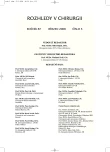Low-Dose Corticosteroids and Septic Shock
Authors:
T. Grendel; V. Hudák; J. Firment
Authors‘ workplace:
I. klinika anestéziológie a intenzívnej medicíny, Lekárska fakulta Univerzity Pavla Jozefa Šafárika, Košice, Slovenská republika, prednosta kliniky: MUDr. J. Firment, Ph. D.
Published in:
Rozhl. Chir., 2008, roč. 87, č. 3, s. 158-164.
Category:
Monothematic special - Original
Overview
Introduction:
Severe sepsis is currently reported the commonest cause of deaths in non-surgical emergency department patients. The aim of the study was to establish degree of complicance with diagnostic and therapeutic procedures in the severe sepsis treatment, as a part of the „Surviving sepsis campaign“. Furthermore, the authors aimed to assess success rates of corticosteroid administration, its effects on circulatory stabilization and to assess the healthcare professionals’ awareness of the campaign.
Methodology:
The patients were assigned to three study groups (n = 103). The following parametres were assessed: complicance with the „resuscitation and management package“, death rate and hydrocortisone administration. An anonymous questionnaire for the medical specialists in individual FNLP Košice clinics was created.
Results:
In the assessed group, the death rate decreased by 15.61% (p < 0.05) in 2006, compared to 2004. Administration of corticosteroids increased by 49.2% in 2006, compared to 2004, while the time interval between the onset of the septic shock symptoms and the catecholamine administration decreased significantly.
Conclusion:
Considering the reduction in the time interval between the onset of the septic shock symptoms and the catecholamine administration, and considering its established positive effects on circulation, it may be concluded that administration of low- dose hydrocortisone in the septic shock treatment is substantiated.
Key words:
severe sepsis – hydrocortisone – catecholamines – Surviving sepsis campaign
Sources
1. Zeerleder, S., Schroeder, V., Lämmle, B., Wuillemin, W., Hack, E., Kohler, H. Factor XIII in severe sepsis and septic shock. Thrombosis Research 2007,119, s. 311–318.
2. Levy, M., Fink, M., Marshall, J., Abraham, E., Angus, D., et al. International sepsis definitions conference. Crit. Care Med., 2003, 31, s. 1250–1256.
3. Annane, D, Bellisant, E., Cavailton, J. M. Septic shock. Lancet, 2005, 365, s. 63–78.
4. Adrie, Ch., Alberti, C., Chaix-Couturier, C., Lassence, A., Cohen, Y., et al. Epidemiology and economic evaluation of severe sepsis in Fance: age, severity, infection site, and place of acquisition (community, hospital, or intensiv care unit) as determinants of workload and cost. Journal of Crit. Care, 2005, 20, s. 46–58.
5. Dellinger, R. P. Carlet, J. M., Masur, H., et al. Surviving sepsis campaign guidelines for management of severe sepsis and septic shock. Intensive Care Medicine, 2004, 30, s. 536–555.
6. Meisner, M. Bimarkers of sepsis: clinically useful? Curr. Opin. Critical Care, 2005, 11, s. 473–480.
7. Gao, F., Melody, T., Daniels, D. F., Giles, S., Fox, S. The impact of compiance with 6-hour and 24-hour sepsis bundles on hospital mortality in patients with severe sepsis: a prospective observational study. Critical Care, 2005, 9, s. 764–770.
8. Firment, J., Záhorec, R. Odporúčania pre liečbu ťažkej sepsy dospelých. Medicínsky monitor, 2004, 3, s. 30–35.
9. Schmidt-loanas, M., Roux, A., Lode, H. New antibiotics for treatment of severe staphylococcal infection in the critically ill patient. Curr. Opin. Critical Care, 2005, 11, s. 481–486.
10. Payen, D., Sablotzki, A., Barie, P. S., Ramsay, G., Lowry, S., et al. International integrated database for the evaluation of severe sepsis and drotrecogin alfa (activated) therapy: Analysis of efficacy and safety data in a large surgical cohort. Surgery, 2005, 5, s. 726–739.
11. Shapiro, N., Howell, M. D., Bates, D. W., Angus, D. C., Ngo, L., Takmor, D. The association of sepsis syndrome and organ dysfunction with mortality in emergency department patients with suspected infection. Annals of Emergency Medicine, 2006, 5, s. 583–590.
12. Lavrentieva, A., Kontakiotis, T., Lazaridis, L., Tsotsolis, N., Koumis, J., Kyriazis, G., Ritzani, M. Inflammatory markers in patients with severe burn injury. What si the best indicator of sepsis? Burns, 2007, 33, s. 189–194.
13. Gaghavan, M., Marik, P. E. Management of sepsis during the early „golden ours“. The journal of emergency medicine, 2006, 31, s. 185–199.
14. Keh, D., Sprung, L. CH. Use of corticosteroid therapy in patient with sepsis and septick shock: An evidence – based review. Critical care medicine, 2004, 32, s. 527–533.
15. Keh, D., Boehnke, T., Weber-Carsten, S., et al. Imunologic and hemodynamic effects of low doses hydrocortison in septic shock: A double-blind, randomized, placebo – controlled, crossover study. Am. J. Respir. Crit. Care Med., 2003, 167, s. 512–520.
16. Yildiz, O., Doganay, M., Aygen, B., et al. Physiological dose steroid therapy in sepsis. Crit. Care, 2002, 6, s. 251–259.
17. Annane, D., Sebille, V., Cherpentier, C., et al. Effect of treatment with low doses of hydrocortisone and fludrocortisone on mortality in patient with septic shock. Jama, 2002, 228, s. 862–871.
18. Oppert, M., Schindler, R., Husung, C., et al. Low-dose hydrocortisone improves shock reversaland reduces cytokine levels in early hyperdynamic septic shock. Crit. Care Med., 2005, 33, s. 2457–2464.
19. Keh, D. Corticosteroid therapy in sepsis: Where are we? Adv. Sepsis, 2006, 5, s. 138–140.
20. Záhorec, R., Firment, J., Straková, J., Mikula, J., Malík, P., Novák, I., Zeman, J., Chlebo, P. Epidemiology of Severe Sepsis in Intensive Care Units in the Slovak Republic. Infection, 2005, 33, s. 122–128.
21. Toporcer T., Radoňák J. Podtlakové uzatváranie rán – nové poznatky a možnosti aplikácie. Čas. lek. čes., 2006, 145, s. 702–707.
22. Annane, D., Briegel, J., Keh, D., Moreno, R., Singer, M., Sprung, C. L. Clinical equipoise remains for issues of adrenocorticotropic hormone administration, cortisol testing, and therapeutic use of hydrocortisone. Critical Care Medicine, 2003, 31, 2250–2251, author reply 2252–2253.
23. http://www.survivingsepsis.org/implement/bundles
24. http://www.ihi.org/IHI/Topics/CriticalCare/Sepsis/Changes/IndividualChanges/Administerlowdosesteroidsbyastandardpolicy.htm
25. http://www.sfar.org/scores2/sofa2.html
26. http://www.sfar.org/scores2/apache22.html
Labels
Surgery Orthopaedics Trauma surgeryArticle was published in
Perspectives in Surgery

2008 Issue 3
Most read in this issue
- Zenker’s Diverticle – Surgical Management
- Scar Hernia Repairs Using a Mesh – The Sublay Technique
- Diagnostics of the Retrocalcaneal Bursitis: Possibilities of the Use of New Anatomical Data
- Central Cervical Dissection of Lymphonodes in the Management of Differentiated Thyroid Carcinoma – Our Experience
